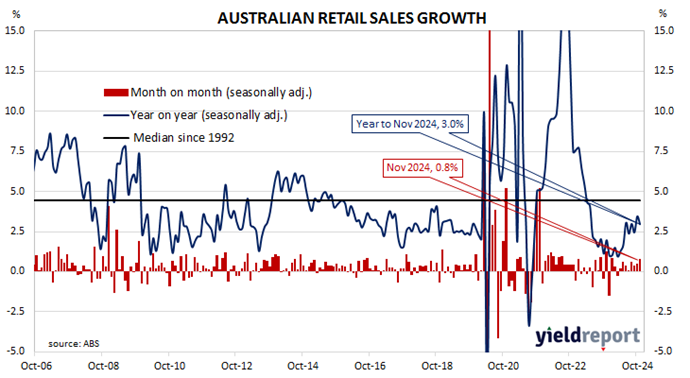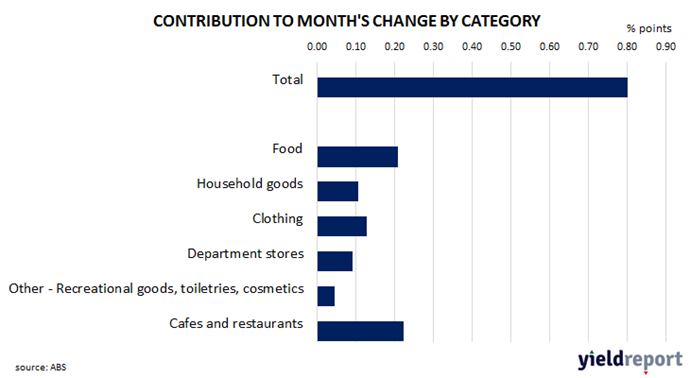Summary: Retail sales up 0.8% in November, less than expected; up 3.0% on 12-month basis; ANZ: figures affirm consumer spending growth is recovering; ACGB yields generally decline; rate-cut expectations firm; Westpac: retail spending looks to be on solid footing in Q4 so far; largest influence on result from restaurants/cafes.
Growth figures of domestic retail sales spent most of the 2010s at levels below the post-1992 average. While economic conditions had been generally favourable, wage growth and inflation rates were low. Expenditures on goods then jumped in the early stages of 2020 as government restrictions severely altered households’ spending habits. Households mostly reverted to their usual patterns as restrictions eased in the latter part of 2020 and throughout 2021.
According to the latest ABS figures, total retail sales increased by 0.8% on a seasonally adjusted basis in November. The result was less than the 1.0% increase which had been generally expected but up from October’s 0.5% rise after revisions. Sales increased by 3.0% on an annual basis, down from October’s comparable figure of 3.5%.
“Today’s retail print is unlikely to have a material impact on the RBA’s decision in February,” said ANZ economist Aaron Luk. “The data affirm that consumer spending growth is recovering, as the RBA has been expecting. The pick-up in household disposable income, including from cost-of-living relief, tax cuts and easing inflation will continue to support household consumption growth in 2025.”
Australian Commonwealth Government bond yields generally declined on the day, although ultra-long-term yields rose a touch. By the close of business, 3-year and 10-year ACGB yields both lost 2bps to 3.89% and 4.52% respectively while the 20-year yield finished 1bp higher at 4.95%.
Expectations regarding rate cuts in the next twelve months firmed, with a February cut currently viewed as a solid chance and two additional 25bp cuts to follow. Cash futures contracts implied an average of 4.27% in February, 3.965% in May and 3.735% in August. December contracts implied 3.585%, 75bps less than the current cash rate.
“Retail spending looks to be on solid footing in Q4 so far and given the late-November timing of the Black Friday sales this year, today’s result could also be an underestimate as the same months in previous years will be capturing the full boost from this event,” said Westpac economist Nema Sharma.
Retail sales are typically segmented into six categories, with the “Food” segment accounting for 40% of total sales. However, the largest influence on the month’s total came from the “Cafes and restaurants” segment where sales rose by 1.5%.



